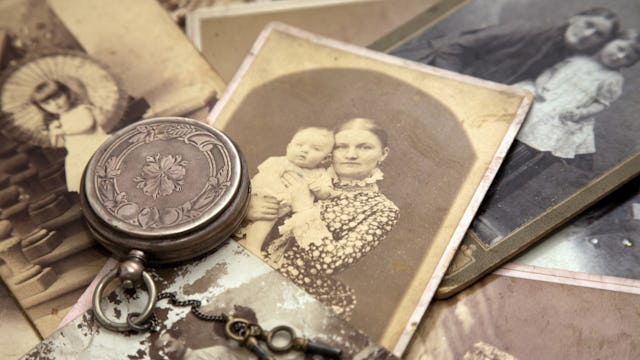Being Pregnant, Giving Birth, And Naming A Baby 100 Years Ago Was A Whole Different Ballgame

Pregnancy and childbirth looked a lot different a hundred years ago (um, thank goodness).
While you’re online scoping out pregnancy resources or thumbing through a copy of What to Expect When You’re Expecting, preggos of yesteryear were consulting publications such as John Kellogg’s Ladies Guide in Health and Disease and John D. West’s Maidenhood and Motherhood, or, Ten Phases of Woman’s Life.
Since there was no such thing as peeing on a stick and waiting for the two lines (or the actual word PREGNANT) back then, you’d have to rely on symptoms. And according to these dudes, who knew so much about being pregnant, there were a few telltale signs besides a measly missed period. “Oft times, the skin becomes loose and wrinkled, giving the young and beautiful wife the appearance of an old, haggard, care-worn woman,” wrote West.
Oh, and food cravings, which Dr. Kellogg believed were mind over matter and could be ignored if the mom-to-be just had some damn self control: “In the majority of cases, the craving is not so strong that it cannot be readily controlled by a little determination on the part of the prospective mother, and when the article craved is manifestly an improper one, the will should be set actively at work to resist the morbid appetite.” Drs. William and Lena Sadler agreed, saying in their 1916 book, The Mother and Her Child, “The woman who habitually eats between meals is the sluggish, constipated individual who needs to acquire self-control and learn self-mastery.”
West, however, disagreed with this viewpoint, saying that pregnant women should indulge their cravings … because if not, “The unsatisfied craving may show itself, as in birth-marks upon the child.”
Whether you indulged or were a paragon of self control, you’d better still be able to squeeze your pregnant heft into that all-important maternity corset, so you could continue to look “trim and shapely.”
Credit: Gossard
When it came time to have the baby, you’d probably stay at home with a rag to bite on, some lard to grease your lady-bits, and likely a midwife in attendance. Of course you’d be wearing the kind of modest outfit suggested for early-20th-century mothers in Louis Spaeth’s book Coming Motherhood: Practical Suggestions Relating to Maternity and the Care of Infants and Children. “Probably the best way to dress a woman for the lying-in-bed is in short undershirt or under vest, shirt waist (blouse) and a skirt or petticoat, warm stockings and bed-room slippers,” he suggests.
Because heaven forbid we forgo the under vest and petticoat, right?
If you gave birth in a hospital, which was being touted as the “new” thing, your doctor may or may not have formal training, and is likely trying to compete with traditional midwifery. In fact, the Drs. Sadler wrote, “Under no circumstances should a midwife be engaged. Any reputable physician or any intellectual minister will advise that. Let your choice be either the hospital or the home; but always engage a physician, never a midwife.”
Doctors marketed their “advantage” by offering fancy gadgets and techniques like forceps (largely un-sterilized and unsanitary) and episiotomies, and new-fangled sedation options such as ether and “twilight sleep.” Although the Sadlers also had this to say about women who chose to punk out and use anesthesia: “It would be a fine form of mental discipline and mighty good moral gymnastics, if a great many self-centered and pampered women would ‘spunk right up’ and face the ordeal of labor with natural courage and normal fortitude.”
It was all a walk in the painful, misogynistic, germ-infested park, which is why childbirth was the leading cause of death for women during this time. But you’d have known what to expect thanks to doctors like Kellogg, who said that he hoped his book would calm women’s fears, and “lead them to choose the slight inconveniences of normal pregnancy and physiological childbirth rather than the dismal comfort of a childless old age …”
Slight. Inconveniences. Eye-roll forever.
Assuming you made it through said “slight inconveniences,” you’d still have the task of naming your offspring — too bad you couldn’t explore the Scary Mommy Baby Name Database back then. If you were going for the trendiest baby names of 1919, you’d be calling your kid one of the year’s top-ranked monikers.
Boys
Girls
Of course, not all parents were giving their kids these uber-hip names. Further down the popularity list, parents of 1919 were naming their sons things like Elmo (#305), Patsy (#324), Mahlon (#623), and Edsel (#731) – and their daughters, Flossie (#257), John (yes, for girls – #370), Hortense (#436), and Dimple (#800). (To see the full list for 100 years ago — or any year, for that matter — type in the year here.)
Whatever you decide to call your baby, your most important job — according to Mother and Child — was to make damn sure little Robert or Ruth wasn’t spoiled. “Nobody is particularly attracted to the spoiled baby,” the authors admonished. “After the over-indulgent parent and caretaker have completed their thoughtless work, they themselves are ashamed of it and not infrequently begin to criticise the product of their own making—the formation of these unpleasant bad habits. More than anything else, the spoiled child needs a new environment, new parents, and a new life.” The Sadlers went on to say that “This sort of ‘spoiled baby crying’ can be stopped only through stern discipline.”
Harsh.
Luckily for the expectant and birthing mothers of today (and their babies … yikes), we’ve come a long way in the past century. We still have a few important factors in common with our pregnant predecessors, though: the desire to be as prepared as we can be, the confusion over which “expert” advice to follow, and the overwhelming hope that our babies will turn out fine.
This article was originally published on